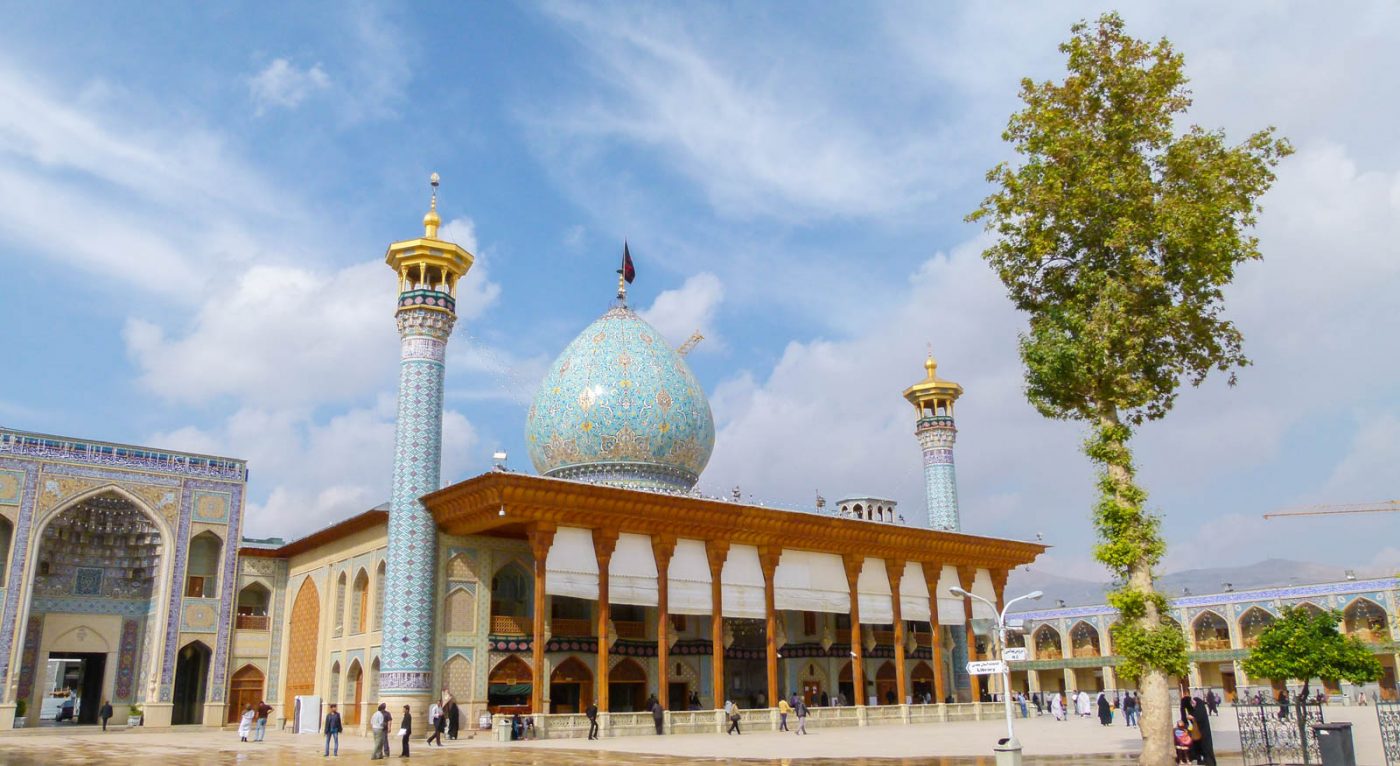
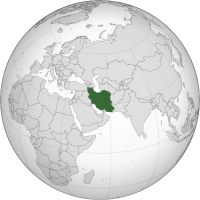 Without a doubt, Iran is one of the most fascinating, friendly and exotic countries that you will ever visit. In this guide, we’ll tell you everything you need to know about backpacking Iran and even share some secrets that you won’t find in your guide-book.
Without a doubt, Iran is one of the most fascinating, friendly and exotic countries that you will ever visit. In this guide, we’ll tell you everything you need to know about backpacking Iran and even share some secrets that you won’t find in your guide-book.
Iran is officially an Islamic Republic, so women travelling here will have to cover up their hair with a head scarf (as well as the rest of their bodies), but don’t worry ladies, these days the head scarf laws are pretty relaxed and you’ll get away with it being almost around your neck.
 IMPORTANT: Since February 2014, the rules for Americans have been extended to include British and Canadian passport holders. This means that Canadians, British and Americans need to be accompanied by a guide while they are in Iran. Contact a tour operator to discuss an itinerary.
IMPORTANT: Since February 2014, the rules for Americans have been extended to include British and Canadian passport holders. This means that Canadians, British and Americans need to be accompanied by a guide while they are in Iran. Contact a tour operator to discuss an itinerary.
Jump To: Must-see Places | Must-Have Experiences | Off The Beaten Path | Pros | Cons | Transport | Visas | Health | Weather | MORE IRAN BLOGS
[widget id=”text-70″]
How Much Will Iran Cost?
**IMPORTANT**
You will need to bring cash (US Dollars Only) with you into Iran to cover the full cost of your trip. ATM’s will not work for foreign debit or credit cards.
Budget: $71/day for 2 people
Backpacking Iran is incredibly inexpensive these days, with the street rate for the Iranian Rial being around 31,850 / $1 USD (Click Here for official / street exchange rate history). Iran is a country that offers great value for money, even more so these days.
The official rate of exchange is 26,827, so rather than exchanging your US Dollars at an official bank, you’re much better off heading to a legal street stall and exchanging your money there (which is totally legitimate).
$71/day is a good budget for two people (around $40/day for a solo-traveller). This will afford a nice double room in a budget hotel, good local meals, the occasional taxi and tour, and taking first class buses everywhere (1st class is only a couple of dollars more than lower classes).
Budget Accommodation: (Average $36 / night with breakfast)
The hotels and guest houses we stayed at cost between $20 – $40 and most included breakfast, while some even included a delicious dinner. All were beautiful budget hotels and many were built out of old homes that have been standing for centuries. You won’t find too many dorms in Iran, but we were at one hotel in Yazd that offered single rates for solo-travellers. While we did stay in nice double rooms, that’s the budget standard in Iran and you won’t find anything much cheaper.
Hotels We Stayed In
|
Mashoud Garmeh Yazd Kerman Shiraz Esfahan Tabriz Tehran |
Hotel Meraj Ateshoonie G.H Koshan Hotel Akhavan Hotel Niyayesh hotel Stayed With Friends Morvarind Hotel Golestan Hotel |
$33 2bedroom apartment, wi-fi, kitchen $35 per person w/breakfast, dinner, wi-fi, shared $20 w/ breakfast, private bathroom & wi-fi $36 w/ breakfast, dinner, private bathroom, wi-fi $25 w/ breakfast, wi-fi, private bathroom FREE $24 w/ breakfast, wi-fi, private bathroom $36 w/ breakfast, wi-fi, private bathroom |
Eating: ($2-$7 / meal)
There are some cheap street meals to be had for backpackers in Iran and sometimes (especially during Ashura), you’ll find free meals all over the place! But eating a nice meal in your hotel restaurant or at a restaurant in town will likely cost between $5 – $10. Food in Iran is delicious and well worth every penny! Don’t miss the date milkshakes!
Entrance Fees: (Free – $10/person)
The entrance fee to Persepolis (one of Iran’s premier historical sites) is around $10. Most people join a tour from Shiraz for around $20 – $25. Some mosques and mausoleums will charge around $3 – $5 for entrance, while parks and some museums are free.
Alcohol: (GOOD LUCK)
 No reason to really put a budget for this here because alcohol is illegal for all Muslim Iranians, and you won’t likely see too much of it, let alone be able to buy it. If you’re really desperate for a drink, you can find wine in Shiraz. Expect to pay around $10 / plastic bottle, but keep it low-key and remember, it’s illegal!
No reason to really put a budget for this here because alcohol is illegal for all Muslim Iranians, and you won’t likely see too much of it, let alone be able to buy it. If you’re really desperate for a drink, you can find wine in Shiraz. Expect to pay around $10 / plastic bottle, but keep it low-key and remember, it’s illegal!
Tipping:
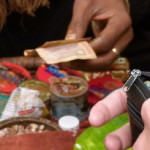
Tipping is not customary in Iran but services that cater to tourists will expect a gratuity. If you’ve hired a guide, a porter or a driver, expect to give a tip at the end. A few dollars should be fine.
Some restaurants, particularly in larger hotels, will add a 10% service charge to the bill. In other places, away from tourist areas, servers will be pleasantly surprised by any change you leave.
If you stay with a local family in Iran (which you most likely will), it’s a good idea to leave a small gift. Something from your home country would be ideal, or you can purchase a nice item from the bazaar to thank your hosts (pottery, a vase, artwork, etc.) Stickers, pens and notepads from your home country are great to give to kids when you leave.
Money:
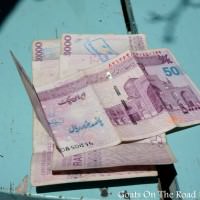 Current Exchange Rate:
Current Exchange Rate:
$1 = 31,850 Rial
**IMPORTANT**
You will need to bring cash (US Dollars Only) with you into Iran to cover the full cost of your trip. ATM’s will not work for foreign debit or credit cards.
The exchange rate in Iran is always changing quickly and has gone through some pretty unstable moments in recent years. In July 2013, after the Rial plummeted to its all-time low of around 40,000 to 1 US dollar, the Central Bank of Iran upgraded its official exchange rate from 12,284 to a more reasonable 20,750, and again in August to 24,500 to the USD, but this is still well below the street exchange rate (which is 31,850 Rial to 1 USD)
Basically, if you go into a bank to exchange your American Dollars into Rial, you will be paying a lot more than if you went into one of the many (legal) street stalls. The cheapest time to backpack Iran was surely July 2013, but it is still a very affordable place to travel.
[widget id=”text-83″]
Must-See Places in Iran
There are far too many “must-see places” to list here. We spent a lot of time in this country and we still have much to see. While we do love seeing sites, the true beauty of Iran is in its people (more about them below).
Jump To: Must-Have Experiences | Off The Beaten Path | Pros | Cons | Transport | Visas | Health | Weather | MORE IRAN BLOGS
Mashhad & The Shrine of Imam Reza:
The city of Mashhad offers little for backpackers, but the immense labyrinth of the shrine complex containing Imam Reza’s mausoleum, (read more about Imam Reza on Wiki here), makes a trip to the city well worth while. It is the largest mosque in the world by dimension and the second largest by capacity (next to Mecca in Saudi Arabia).
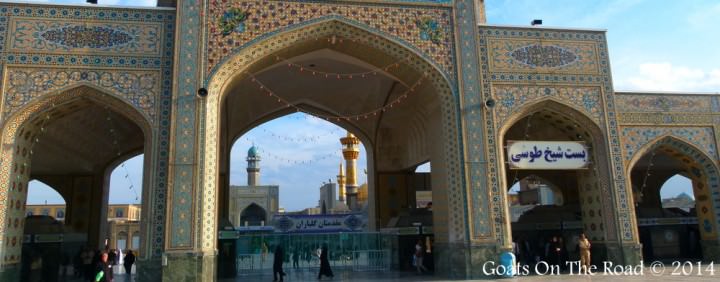
Also contained within the complex are the Goharshad Mosque, a museum, a library, four seminaries, a cemetery, the Razavi University of Islamic Sciences, a dining hall for pilgrims, vast prayer halls, and other buildings.
A visit here is an immensely powerful experience as many people sob and cry out to their lost hero, Imam Reza. Travellers are required to have a guide with them in order to enter this massive complex. We went two times, once by ourselves and once with a guide. It really just depends on how the people at the entrance gates are feeling on that particular day. Also, tourists are not meant to enter the shrine itself, but if you are respectful you may be invited in. Women must wear a chador (which will be provided to you at the entrance) and no cameras are allowed. Entrance is free.
We recommend a late evening stroll, as the shrine is open 24/7. Seeing the many mosaics and intricate carvings on archways and walls, dimly lit by the late evening moon, is a definite highlight.
Garmeh:
While you’re backpacking Iran, you’ll probably want to experience the desert, and there is no better place to do so than in Garmeh. Stay at the Lonely Planet recommended Ateshooni Guest House (they definitely got this one right), and meet Maxiar, a true desert man. Explore this lush, palm shaded oasis with hikes up to lookouts, waterfalls and farmlands.
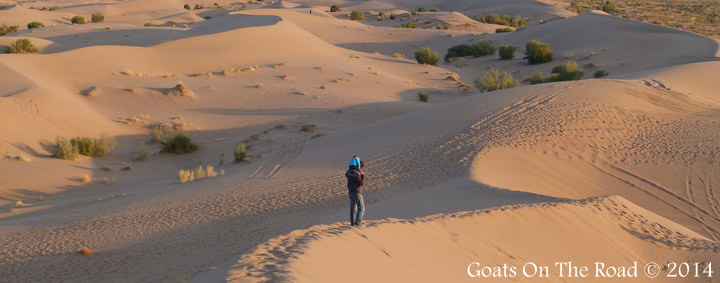
Maxiar can organize trips to the nearby salt flats, sand dunes and villages, but the true appeal to Garmeh is at Ateshooni itself, where Maxiar will play numerous unique instruments and treat you like a VIP family member.
The Lonely Planet makes getting here sound a bit confusing, but call Ateshooni and they’ll clear everything up for you.
The phone number is: +98 324 443 2156 or +98 913 223 0874 and they have a website: www.ateshooni.com
For our experience, Check out: Delightful Desert Days: We Love Iran!
Yazd:
With a population of nearly a half a million people, Yazd is an average-sized city for Iran and it’s the center of the Zoroastrian religion. This labyrinth town of mud and brick is one of the most intriguing places in the country. Get lost in narrow alleyways, where the golden walls seem to close in on you, just before opening up into a beautiful park or mosque courtyard.
Head to the roof for an unforgettable sunset, when the entire city becomes illuminated and the rooftop bagdirs (ancient Iranian air conditioning towers) glow and change colour with the falling sun.
Make sure to do a day trip to the surrounding site of Chak-Chak, the abandoned mud village of Karnaq and the city of Meybod.

Some of the historical sites to see in Yazd:
- Fort Mosque
- Fortifications of Yazd
- Haj Yousef Reservoir
- House of Arab’ha
- House of Larry
- House of Malek al Tojjar
- House of Mortaz
- House of Rasoulian
- Iran Shahr School
- Jame Mosque of Yazd (Grand Mosque of Yazd)
- Khan Bazaar
- Mausoleum of Sahl Ibn Ali
- Mausoleum of Seyed Rokn al Din
- Mausoleum of Seyed Shams al Din
- Mullah Ismail Mosque
- Masoudi Reservoir
- Rig Mosque
- Sheikh Ahmad Fahadan Mausoleum
- Shah Tahmasb Mosque
- Zargari Bazzar
- Ziaiah school
Kerman:
This fantastic, lesser-known city actually has quite a bit to see. Check out the 1,200 meter long “end-to-end covered bazaar”, where you can sample spices and shop for pottery, hookah and textiles. Although Kerman is a nice city, the main draw for coming here is the Kalut Desert (Dasht-e Lut) which is about 100 km northeast of Kerman (2 hour drive).
Stay with Mr. Akhavan at the Akhavan Hotel and he’ll set up everything for you. At just $36 / night, including breakfast and dinner, this place is definitely a good deal!
Hire a taxi and guide (around $30) and head out to the towering sand formations of the Kalut Desert for sunset. Some of these wind-forged sand castles are 10 stories high and their jagged formations take on an alluring golden hue at sunset. You can also arrange to spend the night out in the desert.
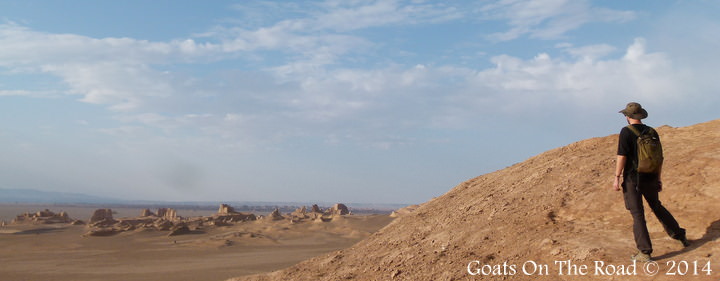
Don’t come here in the summer or during the day as this is where the hottest temperature was ever recorded on Earth (70.7 °C)
 Goat Note: The political situation is always changing in eastern and southeastern Iran. Make sure to check that it is stable before planning a trip here.
Goat Note: The political situation is always changing in eastern and southeastern Iran. Make sure to check that it is stable before planning a trip here.
Shiraz:
The fifth most populous city of Iran and the capital of the Fars Province, Shiraz is another one of Iran’s prime cities for backpackers to visit. This place has been an important trading stop for thousands of years and it is considered to be one of the oldest cities in ancient Persia.
Here you can stay in what is arguably the most beautiful ancient hotel in the country (the Niyayesh Hotel) and enjoy all that this somewhat liberal city has to offer. Shiraz is known as the city of poets, literature, wine and flowers. There are some lovely parks, Unesco listed gardens and stunning mosques. Don’t miss the Ali Ibn Hamza Shrine with its interior of glistening mirrored walls and ceilings.
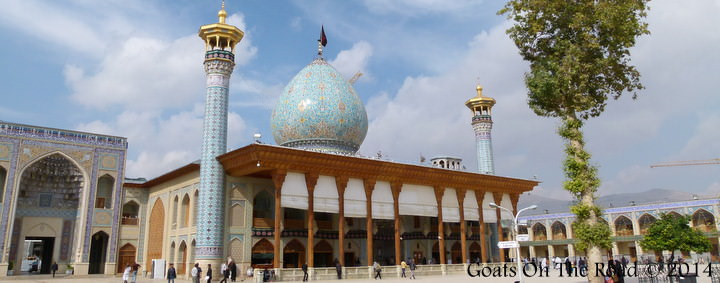
Shiraz is also where Hafez (the famous Iranian poet) was buried, so definitely check out his tomb and have your future read through one of his lovely poetry books.
Persepolis:
These impressive ruins are located inside of a vast, city-like complex and were built over 2,500 years ago. They are found near the town of Marvadasht, but most people take day trips to visit them from Shiraz ($20-$25). This ancient city was once set on fire and looted by Alexander the Great, and further destroyed by subsequent Arab invaders, but despite its rocky past, Persepolis remains one of the most evocative sites in the country and a symbol of the Iranian nationality.

Esfahan (Isfahan):
Esfahan is the third largest city in Iran with many interesting sights to see. Take your pick between parks, squares, palaces, bridges, mausoleums, churches, cathedrals, tombs, mosques, museums and bazaars!
Make sure to see the Khaju Bridge, the 17th century Shahi Bazaar, the Shah Mosque & Shah Square. Visiting the Armenian Quarter (New Julfa) is also recommended. There are some great restaurants, the lovely Vank Cathedral and interesting streets to get lost in. There are so many sites to see in Esfahan that you’ll never be bored!
This city is a highlight of any trip to Iran.
Check out our article: Esfahan, Iran: Taking Hospitality to a Whole New Level
Tabriz:
Located in the far northern reaches, near to the border with Azerbaijan, is the city of Tabriz. This city may seem too far away to bother visiting, but it should definitely be on your Iranian itinerary.
The UNESCO Listed Bazaar of Tabriz is one of the oldest in the Middle East and is the largest covered bazaar in the world. This is a place that you can find anything and everything you might want, and you may get lost too! Make sure to see The Blue Mosque and the Poets’ Tomb as well. The streets in Tabriz are bustling and make the city interesting to walk around. Plus, it’s a very safe city.
As a day-trip, we recommend visiting the troglodyte village of Kandovan. Located in the mountains just two hours from Tabriz, the views here are lovely and the cone-shaped homes are very interesting. Make sure to wear good walking shoes!
Tehran
With stunning rocky mountains as a backdrop, great skiing and cool markets, Tehran is definitely worth lingering in for a couple of days (despite what your guide book might say). The anti-American graffiti at the former US embassy and the incredible collection of gold and diamonds at the Treasury of National Jewels are definitely worth a visit!
Must-have Experiences
Stay With Iranians:
Without a doubt, the most enjoyable part of backpacking Iran is having the opportunity to stay with a local family or friends and learn about the Iranian culture. Luckily for travellers, Iranians are incredibly hospitable and you’ll probably be invited to stay multiple nights in many strangers’ homes. SAY YES! This is the best experience you can have in the country and it will give you invaluable insight into the real Iran.
Jump To: Must-see Places | Off The Beaten Path | Pros | Cons | Transport | Visas | Health | Weather | MORE IRAN BLOGS
Witness Ashura:
If you can time your visit for the mourning ceremonies of Ashura, you’ll have an amazing, first hand look at Iran’s close connection with their faith, history, and lost heroes. Aside from the open sobbing and Self-flagellation in the streets, Ashura is a time to remember those who have made sacrifices. Imam Hussein, the grandson of the prophet Muhammad, was (and still is) a true hero to the Shia Muslim people. Witnessing their sheer devotion and mournful cries is a remarkable experience.
This is also a time for giving and during Ashura, people will often hand out free food and drinks – which can really help the budget!
Note: Make sure to have your transportation and hotels booked during this time as it can be a busy time with locals moving around.
Check out: Ashura, A Month of Sadness and Self-Flaggelation in Iran
Have A Deep Conversation:
You should take the opportunity to have a long and deep conversation with an Iranian. It’s amazing how open and genuine they are. When a local strikes up a conversation with you on a bus or in a cafe, be open to it and you may find yourself truly connecting with them on a very personal level.
 Goat Note: It is illegal for men to speak to unattended women in Iran, so don’t go striking up conversations with pretty Persian girls or you may get arrested.
Goat Note: It is illegal for men to speak to unattended women in Iran, so don’t go striking up conversations with pretty Persian girls or you may get arrested.
Witness Prayer Time:
A great time to visit mosques and mausoleums is during the time of prayer. Even if you’re not a religious person, it can be a moving and calming experience to listen to the meditative chants of the muezzin, and the repetitive replies of the hundreds of people inside of the mosque. Outside of prayer time, the interior of all mosques and mausoleums in Iran are absolutely mind-blowing and definitely worth a visit.
Smoke Qalyan:
The Iranian water pipe is a popular social activity, especially amongst males (but increasingly amongst young females in more modern cities). The substance of choice is flavoured tobacco and it can be quite delicious. Of course it’s not the healthiest past time but everything is okay in moderation! When in Iran right?
Goat Note: In some countries, tobacco water pipes are called Sheesha… not in Iran. Sheesha means crystal meth in Persian, so be sure not to use this term when ordering Qalyan!
Must Try Dishes
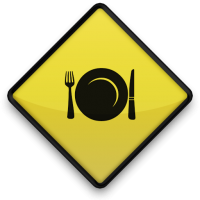 Food is a huge part of travelling to any country and backpacking Iran is no different. Although Iranian cuisine isn’t world-famous, after travelling here you’ll wonder why. The spicy stews, fruity sauces and sweet beverages in Iran are absolutely delicious.
Food is a huge part of travelling to any country and backpacking Iran is no different. Although Iranian cuisine isn’t world-famous, after travelling here you’ll wonder why. The spicy stews, fruity sauces and sweet beverages in Iran are absolutely delicious.
Note: Islam is the dominant religion in Iran, so you won’t find pork in many, if any of the meals.
Fesenjān:
This thick, tart stew is made from pomegranate syrup and ground walnuts. It is traditionally made with poultry (duck or chicken); but there are also variants using balls of ground meat, ghormeh, cut lamb or fish. Finding Fesenjān without meat is not unusual either.
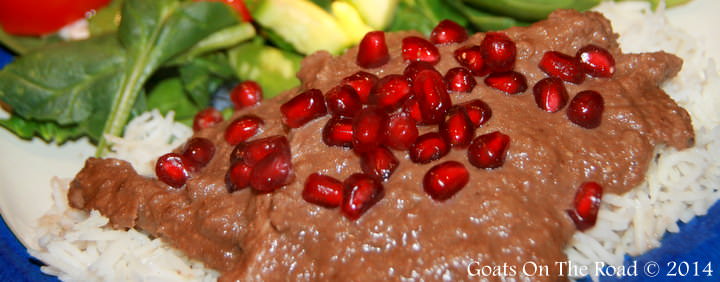
Gormeh Sabzi:
This is often referred to as Iran’s national dish. A delicious stew that literally translates to “stew of greens and herbs”, the main ingredients are a mixture of sautéed herbs (parsley, leeks or green onions, & coriander), seasoned with the key spice of “shambalileh” (dried fenugreek) leaves. In Garmeh you can have Gormeh Sabzi with camel meat!
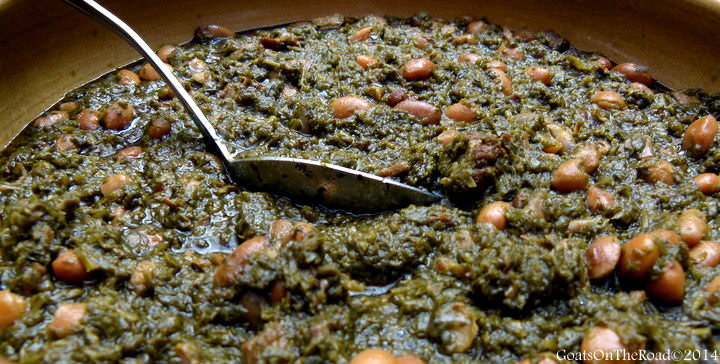
Date Milk Shake:
This seems to be more of a tourist delicacy than an actual Iranian beverage, but there’s no doubt that these frosty, thick mugs of goodness are a hot seller in Iran. Don’t leave without trying a Date Milkshake! You’ll wonder why they don’t have them at every fast food chain and milkshake shop around the world.
Dizi (aka Ābgusht):
Literally meaning “water meat”, this tasty dish may not sound appetizing in its English translation, but it is one of the most delicious meals in Iran, and certainly the most fun to eat. It traditionally comes out in a clay or metal pot with a lid. The savory stew is always served with bread and a pestle on the side, and you are meant to tear up the bread into tiny chunks, put it into the stew and then mush everything together using the provided pestle.
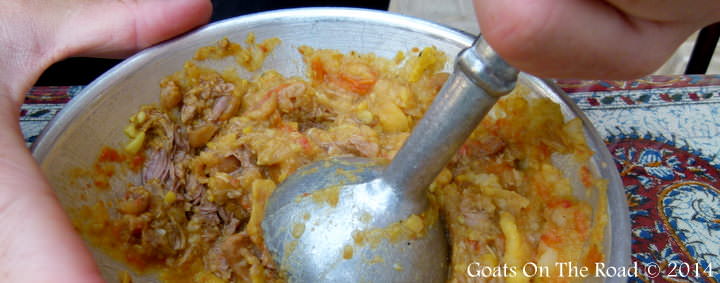
This Persian / Mesopotamian stew is often referred to as “a peasants dish” but it is actually a hearty mutton soup thickened with chickpeas. Usually made with lamb, chickpeas, white beans, onion, potatoes, tomatoes, turmeric and black lime, it is a cheap and filling dish that backpackers can’t get enough of!
Anything you sample in Iran will be delicious. Make sure to sample the street snacks as well!
Off The Beaten Path In Iran
Pros Of Travel In Iran
![]() You’re planning a trip to an amazing place and there are many pros to backpacking Iran. Travel is very personal and different for everybody, so you’ll probably find many more pros when you’re in Iran. We’ve only listed a few.
You’re planning a trip to an amazing place and there are many pros to backpacking Iran. Travel is very personal and different for everybody, so you’ll probably find many more pros when you’re in Iran. We’ve only listed a few.
Jump To: Must-see Places | Off The Beaten Path | Cons | Transport | Visas | Health | Weather | MORE IRAN BLOGS
Incredibly Friendly People!
We’ve said it before and we’ll say it again. Iran has the friendliest people in the world.
Safety:
Despite your friends’ and families’ reaction when you told them you were going to Iran, you’ll probably never feel safer on your travels. The Iranians will treat you like a delicate piece of jewelry when you pass through their country, doing everything in their power to ensure you leave safely, and with a better outlook on the country, its motives and its people.
Amazing Sites:
This is ancient Persia. The historical sites, cities, shrines, mosques and mausoleums here are some of the most exquisite creations you’ll ever see.
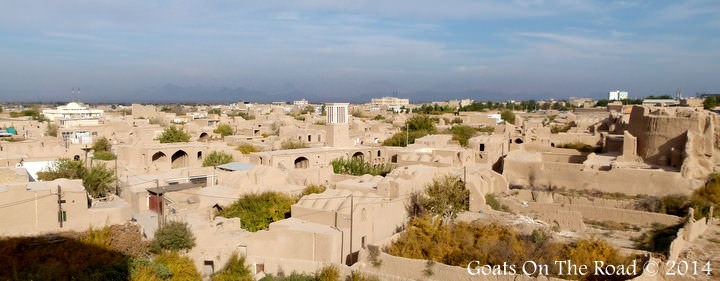
Diversity of Faith & Thought:
Before coming here, you may think that everyone in the country is very conservative and of the strict Muslim faith. This simply just isn’t true. You’ll meet friendly Bahai, Zoroastrians, Christians, Jews, Muslims, Agnostics, Atheists and so much more.
Smashing Misconceptions:
Iran will blow you away. No matter how much you think you know about this place, you will learn so much more when you travel here. When you enter into a family’s home, you’ll probably see men drinking wine and women wearing tank-tops and short skirts. This may throw you for a loop, but it’s what makes Iran so special. There are two worlds here, outside and indoors, and to experience both will help you to shape a new mental picture of Iran and its people.
Amazing Transportation:
Given the current exchange rate, even budget backpackers in Iran will be able to afford to take luxurious 1st class buses and the occasional flight. Transportation here is easy to organize, comfortable and outrageously cheap.
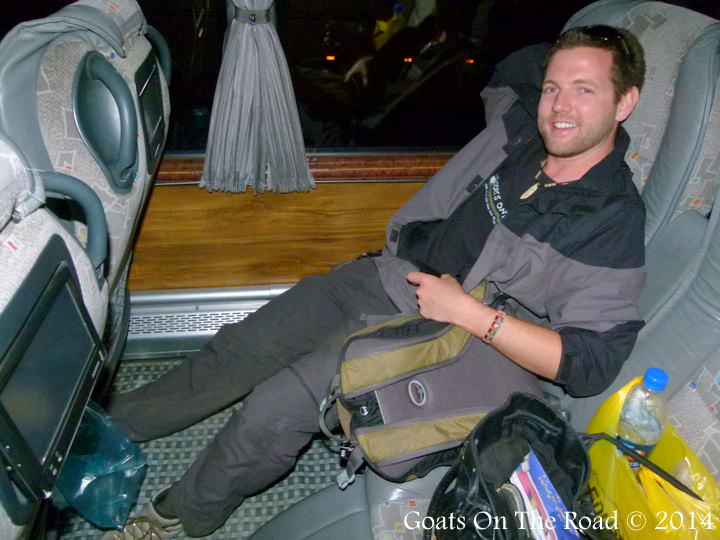
Cons Of Travel In Iran
![]() There are a few cons to backpacking Iran, but in all honesty, it’s hard to think of more than just a few, so we’re really reaching here.
There are a few cons to backpacking Iran, but in all honesty, it’s hard to think of more than just a few, so we’re really reaching here.
Jump To: Must-see Places | Off The Beaten Path | Pros | Transport | Visas | Health | Weather | MORE IRAN BLOGS
Having To Be Covered Up:
Women will be especially affected by this law and it can be very annoying. You must cover your arms, legs, bum and hair at all times (no matter how hot it is) and this will really limit your wardrobe, and possibly your sense of freedom. Just know that many of the women around you don’t want to dress like this either.
**Note: Although the younger generation of Iranian women are pushing the boundaries of the law by having headscarves barely hanging off the back of their heads, be aware of the Morality Police in Iran who drive (and walk) around, looking for people disobeying the law. You must have your head covered and wear appropriate clothing at all times when in public.
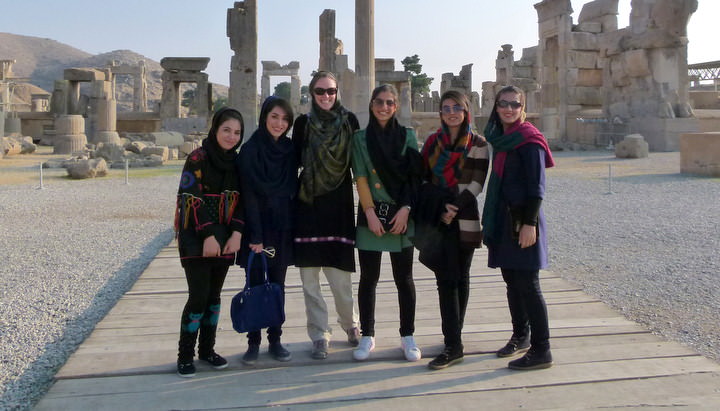
Typical outfits for younger Iranian women, look how far back on the heads those scarves are! As long as your shirt/jacket is covering your bum, you’re ok. Many of the outfits in Iran are actually quite stylish.
No Alcohol:
Well, there is alcohol, if you know where to look, but you won’t be going to bars and getting hammered with other backpackers in Iran. If caught drinking alcohol, you could be looking at some jail time, or a fine. At the same time, it’s very interesting to see how young Iranians entertain themselves into the wee hours of the night, without a drop of alcohol.
No PDA:
 If you’re a couple, you’ll have to keep your smooching and hand holding for when you’re indoors. These are basic cons of travelling in a highly conservative country.
If you’re a couple, you’ll have to keep your smooching and hand holding for when you’re indoors. These are basic cons of travelling in a highly conservative country.
The Heat:
Iran is home to the hottest temperature ever recorded on earth (nearly 71°C!). This means that summer in the southern deserts and Persian Gulf can be unbearably hot.
Internet Restrictions:
You’ll need a VPN (virtual private network) in order to visit websites such as Facebook, Twitter, Google, YouTube, BBC, etc. Somehow our website was able to be connected to in Iran without using a VPN, but most aren’t.
The People In Iran
The people you encounter while backpacking through a country can have a profound impact on the way you view a destination. Not only the local people, but the types of other travellers as well.
Types Of Other Travellers:
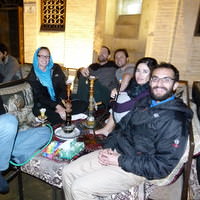 If you’re heading to Iran, you’re going for the same reason that most people are going, to find somewhere unique and off the beaten path. Other travellers in Iran can be a major highlight of your trip, with so many different backpackers on so many different adventures, you’re sure to hear many amazing stories at every hotel and restaurant dinner table. We found the other travellers here to be mature, adventurous, culture-minded and inspiring!
If you’re heading to Iran, you’re going for the same reason that most people are going, to find somewhere unique and off the beaten path. Other travellers in Iran can be a major highlight of your trip, with so many different backpackers on so many different adventures, you’re sure to hear many amazing stories at every hotel and restaurant dinner table. We found the other travellers here to be mature, adventurous, culture-minded and inspiring!
The Locals:

As we’ve said time and time again on this blog and in this Guide, you really can’t beat the friendliness of the Iranian people.
The Iranian people comprise the present day Persians, Ossetians, Kurds, Pashtuns, Tajiks, Balochs, Zaza People, Lurs, and their sub-groups of the historic Medes, Massagetaes, Sarmatians, Scythians, Parthians, Alans, Bactrians, Soghdians and other people of Central Asia, the Caucasus and the Iranian plateau.
Religion In Iran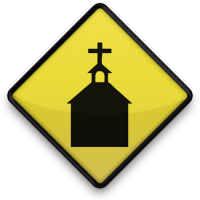
Around 90% of Iranians associate themselves with the Shi’a branch of Islam, the official state religion, and about 9% with the Sunni and Sufi branches of Islam. The remaining 0.9% associate themselves with non-Islamic religious minorities, including Bahá’ís, Mandeans, Yarsanis, Zoroastrians, Jews, and Christians. Sadly, it is illegal for the approximate half million Bahá’ís to publicly practice Bahá’ísm in Iran.
Language In Iran

Many Iranians speak English as a second language and so in most parts of the country, you’ll have no problem finding someone to communicate with (especially in larger cities)
About 75% of the country speaks Persian (Farsi), Gilaki, Mazandarani and Luri, while 11% speak Azerbaijani and other Turkik Dialects. 10% speak Kurdish and 2% consider Balochi their mother tongue. The remaining 2% of people speak other languages including Turkmen, Georgian, Armenian, Hebrew, Assyrian, Brahui etc.
Some Handy Persian Phrases To Know:
Hello/Hi: HiDorud (دُرود) / ruzegâr nik (روزگار نیک)
How are you?: Hâle šomâ cegune ast? (حالِ شما چهگونه است)
Fine, thank you. xubam, sepâs (خوبم، سپآس)
What is your name? nâmetân cist? (نامتان چيست)
My name is ~ .nâmam ~ ast (نامم ~ است)
Nice to meet you. xošbaxtam (خوشبختم)
Please. xâheš mikonam (خواهش میکنم)
Thank you. besiyâr sepâsmandam (بسیار سپاسمنم)
You’re welcome. zende bâšin (زنده باشین)
Yes. âri (آری)
No. na (نَه)
Getting Around In Iran
 You’ll feel like a real luxury traveller when you’re backpacking in Iran. There are some beautiful and enormous buses with wide lounge chairs that lean back all the way, and service that you’d expect to find in a Michelin starred restaurant. You can take trains and taxis that are more affordable than local buses in many other countries, and there are often cheap internal flights as well.
You’ll feel like a real luxury traveller when you’re backpacking in Iran. There are some beautiful and enormous buses with wide lounge chairs that lean back all the way, and service that you’d expect to find in a Michelin starred restaurant. You can take trains and taxis that are more affordable than local buses in many other countries, and there are often cheap internal flights as well.
Getting In & Out
Many people enter Iran by land from Turkmenistan or Turkey as part as a bigger journey through Central Asia.
Iran shares borders with Iraq, Turkey, Azerbaijan, Turkmenistan, Afghanistan and Pakistan. Its northern reaches stretch to the shores of the Caspian Sea while Iran’s southern coast is set along the sun-soaked Persian Gulf.
 By Land
By Land
Turkmenistan: The Saraghs – Sarakhs border is the most popular border entering Iran from Turkmenistan. Opening hours of the border are 8am to 5pm (some say 9 to 6). But be aware, immigration on the Turkmen side closes for lunch from 12 – 1. Also, note that this is one of the slowest border crossings we’ve ever encountered!
From Ashgabat (Turkmenistan), you will need to take a taxi to a passport check station, then an overpriced minibus to the border.
See our article here: Our (Mis)Adventures in Ashgabat, Turkmenistan
Turkey: A popular border crossing is at the town of Dogubayazit. From Ankara it’s a 19 hour bus ride (55TL).
There are also trains going into Iran from Ankara, but make sure you have all of your paperwork ready so that you aren’t left behind at the border. The train from Istanbul to Tehran via Ankara and Tabriz is called the Trans-Asia Express. It runs weekly in either direction departing Istanbul at 10.55pm Wednesday (about €40). It takes about 70 hours and seating is in comfortable 1st-class couchettes with four berths.
Once a week on Tuesday a train departs the city of Van (Turkey) at 8:00 pm for Tabriz, Iran, arriving on Wednesday morning at 6:25 am
Iraq: The best way to enter Iran from Iraq is at the Haj Omoran to Piranshahr border crossing. Of course you can’t get a visa at the border but you can apply for it in Irbil. There are minibuses and taxis to take you to and from the border.
Azerbaijan: The Azeri border has two recognised crossings: between Astara (Azerbaijan) and Astara (Iran), and Culfa (Azerbaijan) and Jolfa (Iran). Visas are not issued here, but there are some mini-buses and taxis to take you to and from the border on either side.
Armenia: The border between Iran and Armenia is only 35km long, with one crossing point in Iran at Norduz.
Afghanistan: The border at Dogharon, 20km east of Taybad, is open and straightforward. Daily buses between Herat and Mashhad make the trip even simpler still.
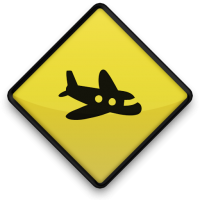 By Air
By Air
There are two international airports in Tehran, the older and less used Mehrabad International Airport (THR) and the newer and updated Khomeini International Airport (IKA) (named after Iran’s religious leader). All international flights to Tehran will arrive at the latter.
Iran also has international airports in Shiraz, Esfahan, Bandar Abbas and Kish, with Shiraz being the easiest starting point for travellers. Iran is huge, so when entering by air, make sure to plan a good route so you don’t backtrack or run out of time.
Iran Air is the national airline and has a pretty good reputation. It’s interesting, on some international airlines, when you fly outside of Iran’s airspace, you’ll be served alcohol after it is announced on the P.A!
Jump To: Must-see Places | Off The Beaten Path | Pros | Cons | Health | Weather | MORE IRAN BLOGS
Visa Regulations For Iran
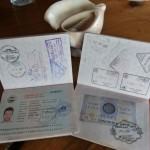
IMPORTANT: As of February 2014, citizens of the UK, US and Canada will need to be accompanied by a guide and have a specified itinerary to visit Iran.
**Note: Entrance to Israeli passport holders will be refused. As will entrance to those with evidence of travel to Israel. Obtain a new passport before your trip to Iran if you need to!
UPDATE 2017: Good news! 180 different countries can now get an Iran visa on arrival. Still, if you’re from USA, Britain, Canada, Colombia, Bangladesh, Jordan, India, Afghanistan, Pakistan or Somalia there’s no visa on arrival for you. For more, check out this post.
There’s no doubt that visas are going to be an issue when you’re planning your trip to Iran. Everyone except for nationals of Turkey, Malaysia, Syria, Georgia, Azerbaijan (15 days), Venezuela, Nicaragua, Bolivia and Ecuador will have to obtain a visa at an Iranian consulate abroad, before entering Iran.
To apply for your Iranian visa, you will first need to obtain a reference number (similar to a Letter Of Invitation) before you apply at the consulate. To obtain your reference number, contact Stan Tours and fill out their application, which will require you to state which consulate you will pick up your Iran visa. After a few days of processing, Stan Tours will send a reference number to you, which you will need to present to the consulate when you apply.
We highly recommend you contact Stan Tours for all of your reference numbers, Letters of Invitation and visa needs in Iran and Central Asia.
Goat Note: We don’t get paid to promote Stan Tours. We just know that they’re the best.
30 Day tourist visas will cost:
- UK: $230 – $340 USD
- German: $77 USD
- Spanish: $95 USD
- Australian: $125 – $230 USD
- Japanese: $75 USD
- Korean: $50 USD
- Finnish: $50 USD
- Slovak: $65 USD
- New Zealand: $128 USD
The best places to apply for an Iran Visa:
The best places to obtain your Iranian visa are at consulates in Trabzon (Turkey), Almaty (Kazakhstan) or Batumi (Georgia), since you do not need a Letter Of Invitation. Another good place to pick up the Iran Visa is in Dushanbe (Tajikistan), as the turn around time can be as short as 48 hours! Bishkek is a cheap place to get the Letter Of Invitation.
Visa regulations are as follows:
Every nationality will need to obtain a visa (but first a reference number) before entering Iran except for the following:
References:
Some of the above information was found on Caravanistan and Wikipedia. Caravanistan also offers similar visa support to Stan Tours.
Health In Iran
![]()
Food, medical and health standards are all quite high in Iran so you shouldn’t have many issues with sickness or disease. There is some risk of malaria in south-eastern Iran, but travellers should be cautious when taking dangerous anti-malarial medications in a country with such a low risk. The most common form of sickness that travellers face is food poisoning (although this is quite rare).
There is no risk of yellow fever in Iran, but animals can carry rabies, so like anywhere in the world, keep your distance from stray animals and unkempt pets.
[widget id=”text-83″]
Jump To: Must-see Places | Off The Beaten Path | Pros | Cons | Transport | Visas | Weather | MORE IRAN BLOGS
Phone & Internet In Iran
![]() The Iranian government does censor many social and overseas news sites like BBC, Twitter, Facebook etc. They also throttle back the speeds to ensure that nobody is downloading illicit materials, but generally you’ll still be able to find decent speeds at cafes, restaurants and at your hotel. Wi-fi is becoming increasingly popular and you’ll likely have it at almost every hotel you stay in. Download speeds average at about 1mbps, but you’ll likely get around 500kbps.
The Iranian government does censor many social and overseas news sites like BBC, Twitter, Facebook etc. They also throttle back the speeds to ensure that nobody is downloading illicit materials, but generally you’ll still be able to find decent speeds at cafes, restaurants and at your hotel. Wi-fi is becoming increasingly popular and you’ll likely have it at almost every hotel you stay in. Download speeds average at about 1mbps, but you’ll likely get around 500kbps.
As for mobile service, Iran’s telecommunications are run entirely by one state-run company: TCI. Travellers can obtain both static sim cards and pre-paid sim cards. You can recharge Your sim card through Internet, by using major Iranian debit cards, or simply buy a recharge card from any super store, book store or mobile service provider shops which are available all around Iran. Sim cards have SMS, MMS and GPRS.
TCI still doesn’t support 3G but this is on its way. You may be able to use your original sim card from home, but you will pay roaming charges.
Good Movies & Books About Iran
Movies:
Argo: This 2012 film was directed by Ben Afflek and while it was criticized for poorly portraying the Iranian people, although parts of it are fictitious it is actually quite entertaining and informative.
A Separation: This compelling drama is about a married couple who are faced with a difficult decision to either improve the life of their child by moving to another country, or to stay in Iran and look after a deteriorating parent who has Alzheimer’s disease.
Books:
Prisoner of Tehran: The true story of a 16-year-old girl living in Tehran during the Iranian Revolution. What she went through in her life during this time is unimaginable. This is one book you won’t want to put down.
When Is The Best Time To Visit Iran?
![]()
Spring (March-May) & Autumn (Sept-Nov)
Thanks to Iran’s size, topography and altitude, you’ll actually find a huge variety of weather patterns here. Before you decide when to go, you should probably figure out where you’d like to go in the country as regional temperatures can vary wildly (when it’s -5°C in Tabriz it might be 35°C in Bandar Abbas).
Heat can be a restrictive force when backpacking in Iran so be careful if you’re in the south during summer, when temperatures frequently break into the 40’s (C).
Goat Note: Weather throughout the world is changing. You can’t even try to predict seasons anymore, but you can assume that central and northern Iran is mostly freezing after November and the south is scorching in the summer.
Jump To: Must-see Places | Off The Beaten Path | Pros | Cons | Transport | Visas | Health | MORE IRAN BLOGS
Overall Thoughts
Iran is definitely one of our favourite countries to date!
Iran’s remarkably friendly people, the ease of travel, interesting sites, amazing topography and deep history all combine to make this one of the most captivating travel destinations on Earth. Forget what your family and friends say about Iran and its people. Unless they’ve been there, they have no idea. Pack your bags and get ready for a cultural experience that will likely remind you of exactly why you love travel.
Jump To: Must-see Places | Off The Beaten Path | Pros | Cons | Transport | Visas | Health | Weather | MORE IRAN BLOGS
Like it? Pin it!
Disclaimer: Goats On The Road is an Amazon Associate and also an affiliate for some other retailers. This means we earn commissions if you click links on our blog and purchase from those retailers.



